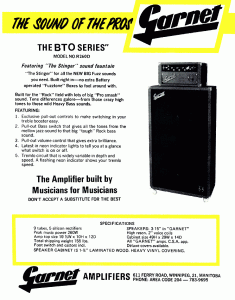Garnet Amplifiers
Canadian Amplifiers – Garnet
Aside from being the creator of the ‘Garnet’ line of guitar amplifiers used by Canadian supergroups The Guess Who and Bachman Turner Overdrive, Mr. Thomas ‘Gar’ Gillies has a very colorful past. This includes fronting The Gar Gillies Orchestra and working as the radio repair technician for the Winnipeg Eaton’s department store (a Canadian equivalent to Sears/Roebuck) during the 1930’s! Garnet also manufactured the Gibson Lab Series amplifiers during the early 1980’s right here in Winnipeg. Choose from a few different vintage Garnet catalog inserts, or one other surprise.
Garnet Amplifier #1!
The very first ‘commercial’ Garnet amplifier built!
Check out the photos below of the very first Garnet amplifier! According to Gar, there were no more than 12 of these amplifiers called ‘The Pro‘ built, around the spring of 1966. Now that’s a collectible! Note the different style logo. Note also the very funky grille cloth, which was originally the seat cover from a 1930’s Chevy! This amplifier was built on a prefabricated aluminum chassis, and used Hammond transformers. Note also that the front control panel looks suspiciously like the well-known BTO, and features pullout knobs for ‘boosts’ on the Treble and Bass, with the Volume having a ‘pull-bright’ function. The earliest Garnet amplifier models, called ‘The Pro‘, ‘The Assistant Pro’, and ‘The Rebel‘ all had the same panel layout. (‘The Assistant Pro‘ had no ‘Tremolo’ or ‘Stinger’, while ‘The Rebel‘ had no ‘Tremolo’). The BTO was the ‘Big Daddy’ of the line (at the time), and put out 150 watts before clipping! The ‘Stinger‘ distortion circuit can be seen on the left-hand side of the chassis, and the ‘Tremolo’ controls are on the right.


It is believed no more that 12 of these were built.
The BTO, the undisputed flagship of the Garnet line.
Below is an old image and a catalog insert for the BTO, probably the most sought after Garnet amplifier. Most likely due to the fact that only about 300 were made during a three year time span, the heads fetch ‘silly money’ in the U.S. of A, while the cabinets don’t. This is a crying shame because the cabinet came optionally in a 4X12″ set-up with 70-watt Marsland speakers ‘featuring’ Alnico V magnets. Can you say “but-tah”? I own a 4X12″ BTO cabinet and it is the smoothest sounding bass cabinet I have ever heard. Getting back to the head, four EL34’s with a high voltage supply easily gave 150 watts of output power (before clipping) into a standard cabinet with three 15″ speakers (Model R260D) or two 15″ speakers and one horn (Model L260D, as shown above). Greg Leskiw (who replaced Randy Bachman in The Guess Who) insisted on JBL’s for the 15″ speakers in his BTO cabinets, making this amplifier/cabinet LOUD! There are many slight variations in the construction of the head, which include;
- The original chassis mounts ‘upside down’ on the top of the cabinet (as shown above; think Fender) while the later version chassis mounts on the bottom (think Marshall).
- Brass trunk corners were used on all earlier Garnet amplifiers, including the BTO’s. Chrome corners equals 1970’s amplifiers.
- The ‘Stinger’ was a 6AN8 on a few of the earliest BTO’s, followed by a 6AU6 and finally the much more seen 6JW8. FYI; The ‘Stinger’ is NOT the same as a ‘Herzog’. The ‘Tremolo’ on some models may also use a 6AU6 and have a ‘swing’ that is to die for! This is because the voltage gain of a 6AU6 (pentode) is much higher that the triode section of either the 6AN8 or 6JW8. This gives HUGE depth to the ‘Tremolo’.
- The original silk-screened ‘Garnet’ EL34’s are Siemens tubes! Gar is also one of only two manufacturers I know (the other being Traynor) that used an EL34 in a way that promotes tube reliability, but still I definitely wouldn’t put anything but a top-notch EL34 in this amplifier, unless you are prepared to seriously modify the screen and bias supply.
- There was a ‘Bass’ version available (below), that would give any Ampeg SVT a serious run for its’ money! These are identified by the bass clefs attached to the head and cabinet. The BTO 600 put out a clean 225 watts RMS with six EL34’s.
 The catalog insert for the BTO
The catalog insert for the BTO
The Garnet Li’l Rock.
The Garnet Li’l Rock amplifier is very similar electronically to a Tweed-era Fender Deluxe amplifier (the phase inverter tube in a Li’l Rock is a 6SN7). The taller cabinet is sealed only for the bottom 2/3rds of the ‘speaker compartment’, leaving the top chassis area open. The added height and closed back yields a little more bottom-end ‘oomph’ or push to the tone. Traynor took this idea to heart with their Guitar Mate amplifiers (see the Traynor section of Made in Canada). This is one my favorite Garnet amplifiers, because it is so portable, and has great tone. The 20 watts of output power may not be enough for most gigging situations, but it makes an excellent practice/recording amplifier. Similar to the Li’l Rock was the Mach 5 amplifier (basically a Li’l Rock with tremolo) which came out in three versions; 1) With a transformer ‘impedance coupled’ phase inverter. 2) With a ‘normal’ 6SN7 phase inverter. 3) With a 6SN7 phase inverter tube and a 6CG7 driving a Reverb circuit. This would be very close to a single-channel Deluxe Reverb, but at a considerable saving compared to today’s prices for a vintage piece.



